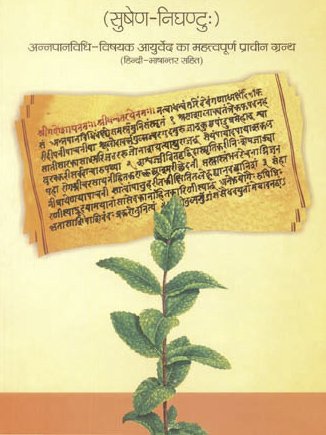Shakavarga, Śākavarga, Shaka-varga: 4 definitions
Introduction:
Shakavarga means something in Hinduism, Sanskrit. If you want to know the exact meaning, history, etymology or English translation of this term then check out the descriptions on this page. Add your comment or reference to a book if you want to contribute to this summary article.
The Sanskrit term Śākavarga can be transliterated into English as Sakavarga or Shakavarga, using the IAST transliteration scheme (?).
In Hinduism
Ayurveda (science of life)
Nighantu (Synonyms and Characteristics of Drugs and technical terms)
Source: Wisdom Library: Raj NighantuŚākavarga (शाकवर्ग) or Śāka is another name for Mūlakādi: the seventh chapter of the 13th-century Raj Nighantu or Rājanighaṇṭu (an Ayurvedic encyclopedia). The Rāja-nighaṇṭu is a medical lexicon ascribed originally known as the Abhidhānacuṇāmaṇi. It mentions the names of 1483 medicinal drugs (auṣadhi) and substances (dravya) excluding synonyms, grouped into twenty-two chapters [viz., Śāka-varga].
Unclassified Ayurveda definitions
Source: Wisdom Library: Āyurveda and botanyŚākavarga (शाकवर्ग) is the Sanskrit name for a group of medicinal plants, classified as “pot-herbs/vegetables”, of which the leaves, stems and fruits are used. It was and originally composed by Caraka in his Carakasaṃhitā sūtrasthāna XXVII. The name is derived from the words śāka (translating to ‘vegetable’, but alternatively refers to a potherb) and varga, translating to “group” or “family”. It is a technical term used throughout Āyurveda.
The following plants are described as pertaining to this category:
- Pāṭhā,
- Kāsamarda,
- Śaṭī,
- Vāstuka,
- Suniṣaṇṇaka,
- Kākamācī,
- Rājakṣavaka,
- Kālaśāka,
- Cāṅgerī,
- Upodikā,
- Taṇḍulīya,
- Maṇḍūkaparṇī,
- Vetrāgra,
- Kucelā,
- Vanatiktaka,
- Karkoṭaka,
- Bākucī,
- Paṭola,
- Śakulādanī,
- Vāsā / Vṛṣa,
- Śārṅgeṣṭā,
- Kembūka,
- Kaṭhillaka,
- Nāḍī,
- Kalāya,
- Gojihvā,
- Vārtāka,
- Tilaparṇikā,
- Kulaka,
- Karkaśa,
- Nimba,
- Parpaṭaka,
- Phañji,
- Cillī,
- Kutumbaka,
- Āluka,
- Kuṭiñjara,
- Śana,
- Śālmali,
- Karbudāra,
- Suvarcalā,
- Niṣpāva,
- Kovidāra,
- Pattūra,
- Cuccuparṇikā,
- Kumārajīva,
- Loṭṭāka,
- Pālaṅkyā,
- Māriṣa,
- Kalamba,
- Nālikā,
- Āsurī,
- Kusumbha,
- Vṛkadhūmaka,
- Lakṣmaṇā,
- Cakramarda,
- Nalinīkā,
- Kuṭheraka,
- Loṇikā,
- Yavaśāka,
- Kūṣmāṇḍaka,
- Avalguja,
- Yātuka,
- Śālakalyāṇī,
- Triparṇī,
- Pīluparṇikā,
- Śaṇa,
- Vaṭa,
- Undumbara,
- Aśvattha,
- Plakṣa,
- Padma,
- Vatsādanī,
- Gaṇḍīra,
- Citraka,
- Śreyasī,
- Bilvaparṇī,
- Bilva,
- Bhaṇḍī,
- Śatāvarī,
- Balā,
- Jīvantī,
- Parvaṇī,
- Parvapuṣpī,
- Lāṅgalikā,
- Eraṇḍa,
- Tila,
- Vetasa,
- Trapusa,
- Ervāruka,
- Alābu,
- Cirbhaṭa,
- Kūṣmāṇḍa,
- Kelūṭa,
- Kadamba,
- Nadīmāṣaka,
- Ainduka,
- Utpala,
- Tālapralamba,
- Kharjūra,
- Tāla,
- Tarūṭa,
- Krauñcādana,
- Kaśeruka,
- Śṛṅgāṭaka,
- Aṅkaloḍya,
- Muñjātaka,
- Vidārīkanda,
- Amlikā,
- Sārṣapa,
- Piṇḍāluka,
- Chattra (various).
The collection of herbs named Śākavarga is one of the seven groups that were classified based on its dietic value.
Source: archive.org: Science And Technology In Medievel India (Ayurveda)Śākavarga (शाकवर्ग) refers to the “group of vegetables” and is one of the 18 chapters of the Dravyaguṇasaṃgraha, as mentioned in A. Rahman’s Science and Technology in Medievel India: A bibliography of source materials in Sanskrit, Arabic and Persian.—Ancient and medieval India produced a wide range of scientific manuscripts and major contributions lie in the field of medicine, astronomy and mathematics, besides covering encyclopedic glossaries and technical dictionaries.—The Dravyaguṇasaṃgraha deals with cooking and eating in 18 sections [e.g. Śākavarga].
Source: gurumukhi.ru: Ayurveda glossary of termsŚākavarga (शाकवर्ग):—Group of green leafy vegetables, roots and tubers.

Āyurveda (आयुर्वेद, ayurveda) is a branch of Indian science dealing with medicine, herbalism, taxology, anatomy, surgery, alchemy and related topics. Traditional practice of Āyurveda in ancient India dates back to at least the first millenium BC. Literature is commonly written in Sanskrit using various poetic metres.
See also (Relevant definitions)
Partial matches: Shaka, Varga.
Full-text (+159): Shaka, Kucela, Dhulikadamba, Phanji, Keluta, Dharakadamba, Nadimashaka, Tilaparnika, Bhumikadamba, Ainduka, Kathillaka, Kutinjara, Kutumbaka, Aluka, Manduki, Mulakadi, Vrikadhumaka, Dirghapatraka, Kushmandi, Kumbhandi.
Relevant text
Search found 3 books and stories containing Shakavarga, Śākavarga, Shaka-varga, Sakavarga, Saka-varga, Śāka-varga; (plurals include: Shakavargas, Śākavargas, vargas, Sakavargas). You can also click to the full overview containing English textual excerpts. Below are direct links for the most relevant articles:
Charaka Samhita (English translation) (by Shree Gulabkunverba Ayurvedic Society)
Chapter 27d - The group of vegetables (Shaka) < [Sutrasthana (Sutra Sthana) — General Principles]
Atharvaveda and Charaka Samhita (by Laxmi Maji)
Hārīta (Āyurveda scholar) < [Chapter 1 - Introduction]
Vanaspati (Plants) used in Veda < [Chapter 2 - The nature of treatment for diseases in the Ancient era]
Kautilya Arthashastra (by R. Shamasastry)
Chapter 15 - The Superintendent of Store-house < [Book 2 - The duties of Government Superintendents]